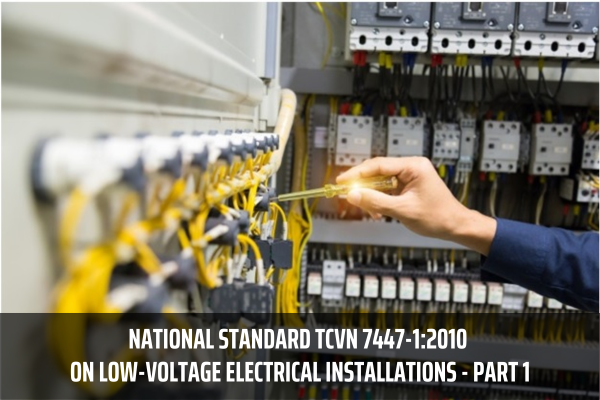What is the National Standard TCVN 7447-1:2010 (IEC 60364-1:2005) on Low-voltage electrical installations - Part 1 in Vietnam?
What is the National Standard TCVN 7447-1:2010 (IEC 60364-1:2005) on Low-voltage electrical installations - Part 1 in Vietnam?
National Standard TCVN 7447-1:2010 (IEC 60364-1:2005) on Low-voltage electrical installations - Part 1 replaces TCVN 7447-1:2004;
National Standard TCVN 7447-1:2010 is fully equivalent to IEC 60364-1:2005;
National Standard TCVN 7447-1:2010 is compiled by the Technical Committee TCVN/TC/E1 Electrical machines and appliances, under the direction of the General Department of Quality Measurement Standards, Ministry of Science and Technology.
The scope of application of National Standard TCVN 7447-1:2010 is as follows:
TCVN 7447-1:2010 provides rules for the design, installation, and testing of electrical installations. These rules aim to ensure the safety of people, animals, and property from hazards or damages that may arise from the proper use of electrical installations and to ensure the correct operation of these installation systems.
TCVN 7447-1:2010 applies to the design, installation, and testing of electrical installations in:
- Residential buildings;
- Commercial buildings;
- Public buildings;
- Industrial buildings;
- Agricultural and horticultural buildings;
- Prefabricated buildings;
- Dwellings, caravan parks, and similar locations;
- Construction sites, exhibition areas, fairs, and other temporary installation systems;
- Marinas and boats;
- Outdoor lighting systems and similar installation systems (except for 11.3e));
- Healthcare-related areas;
- Mobile or transportable units;
- Optical fiber systems;
- Low-voltage power generating sets.
NOTE: "Building" includes both the land and all equipment, including buildings, within the construction.
TCVN 7447-1:2010 refers to:
- Electrical circuits supplied at a nominal voltage up to and including 1000V AC or 1500V DC;
For AC, the preferred frequencies considered in this standard are 50Hz, 60Hz, and 400Hz. The use of other frequencies for specific purposes is not excluded.
- Electrical circuits, excluding internal wiring systems of equipment, operating at voltages exceeding 1000V and derived from an installation system with a voltage not exceeding 1000V AC, for example, discharge lighting, electrostatic filters;
- All wiring systems and cables not specifically covered in equipment standards;
- All consumer installation systems located outside buildings;
- Fixed wiring systems used for information technology and telecommunications, signaling, control, and similar systems (excluding wiring systems inside equipment);
- Extensions or modifications to existing installation systems, as well as parts of the installation system affected by these extensions or modifications.
NOTE: The rules of TCVN 7447-1:2010 apply to electrical installations in general, but in certain cases, they may require additional requirements or recommendations from other IEC standards (e.g., for electrical installations in explosive atmospheres).
TCVN 7447-1:2010 does not apply to:
- Electric traction equipment, including electric vehicle charging stations and signal devices;
- Electrical apparatus of electric road vehicles, except for the devices mentioned in Part 7 TCVN 7447-1:2010;
- Electrical installations on ships, offshore fixed and mobile drilling rigs;
- Electrical installations on aircraft;
- Public street lighting systems as part of the public electricity supply network;
- Installation systems in mines and underground works;
- Radio frequency interference suppression devices, if they do not affect the safety of the installation system;
- Electric fences;
- External lightning protection systems (LPS);
NOTE: This standard does mention atmospheric phenomena but only to the extent that they affect electrical installations (e.g., related to the selection of surge protective devices).
- Certain aspects of elevator installation systems;
- Electrical apparatus of machinery.
TCVN 7447-1:2010 is not suitable for application to:
- Public electricity distribution systems, or
- Generation and transmission of electricity for these systems.
NOTE 1: However, countries may still apply all or part of this standard for these purposes.
NOTE 2: IEC 61936 provides general rules for the design and installation of electrical installations in systems with a nominal voltage above 1 kV AC and a nominal frequency up to and including 60 Hz, but low-voltage AC and DC protection and monitoring systems still need to comply with TCVN 7447 (IEC 60364) standards.
TCVN 7447-1:2010 only addresses the selection and application of electrical equipment in installation systems.
This also applies to assemblies of electrical equipment complying with relevant standards.

What is the National Standard TCVN 7447-1:2010 (IEC 60364-1:2005) on Low-voltage electrical installations - Part 1 in Vietnam? (Image from the Internet)
Vietnam: What are basic principles under the TCVN 7447-1:2010?
In Section 3 of TCVN 7447-1:2010, the following basic principles are stated:
- For countries that do not have state regulatory documents on electrical installation systems and feel the need to establish legal requirements for this purpose, it is recommended that such requirements be limited to basic principles that are not influenced by frequent changes due to technical developments. The content of Article 13 can be used as a basis for developing those regulatory documents.
- This article outlines the basic requirements, while other parts of this standard (Table A.2) will provide more specific requirements.
What are general requirements for safety protection in Vietnam under the National Standard TCVN 7447-1:2010?
In Section 131.1 of TCVN 7447-1:2010, the following general requirements are stated:
The requirements stated in Articles 131.2 to 131.7 are aimed at ensuring the safety of humans, animals, and property from hazards and damages that may arise during the proper use of electrical installation systems. The requirements to ensure the safety of animals may be applicable in areas designated for those animals.
In electrical installation systems, the following risks may occur:
- Electric shock;
- Excessive temperatures capable of causing burns, fires, and other harmful effects;
- Atmospheric phenomena capable of causing explosions;
- Low voltage, overvoltage, or electromagnetic effects likely to cause injury or damage;
- Interruptions to the power supply and/or interruptions to safety services;
- Arcing, which is likely to cause blindness, excessive pressure, and/or toxic gases;
- Mechanical motion of equipment activated by electricity.
LawNet